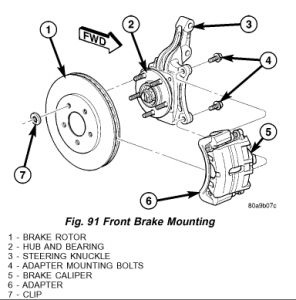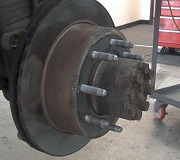Hello - Mike
You didn't specify so I used a 3.3L VIN R to look at.
Well hard to say since I don't know where you hit. Normally a vibration when applying brakes like you describe means a bad rotor. . ...but you replaced those.
I suppose you hit them because they were rusted on. . ...did you wire brush really good the surface before installing the new rotor? If not it may not be sitting flat.
Did you have to strike the caliper at all to get it off?
Are you sure the pads can move freely, nothing slipped out and is sitting odd against the puck?
For the bearing, again since I am not sure where and how hard you hit, the bearing is questionable. I have attached info on that for you. It needs to be replaced all as one unit though if you do it. . ..i.e., the hub and bearing are together.
I also attached a check for you.
HUB / BEARING
DESCRIPTION
The front wheel bearing and front wheel hub of this vehicle are a hub and bearing unit type assembly (Unit III). This unit combines the front wheel mounting hub (flange) and the front wheel bearing into a sealed one-piece unit. The hub and bearing is mounted to the center of the steering knuckle (Fig. 1). It is retained by four mounting bolts accessible from the inboard side of the steering knuckle. The hub flange has five wheel mounting studs.
The wheel mounting studs used to mount the tire and wheel to the vehicle are the only replaceable components of the hub and bearing assembly. Otherwise, the hub and bearing is serviced only as a complete assembly.
OPERATION
The hub and bearing has internal bearings that allow the hub to rotate with the driveshaft, along with the tire and wheel. The five wheel mounting studs mount the tire and wheel, and brake rotor to the vehicle.
HUB AND BEARING
The condition of the front hub and bearing assembly is diagnosed using the inspection and testing procedure detailed below.
The bearing contained in the Unit III front hub/ bearing assembly will produce noise and vibration when worn or damaged. The noise will generally change when the bearings are loaded. A road test of the vehicle is normally required to determine the location of a worn or damaged bearing.
Find a smooth level road surface and bring the vehicle up to a constant speed. When vehicle is at a constant speed, swerve the vehicle back and forth from the left and to the right. This will load and unload the bearings and change the noise level. When bearing damage is slight, the noise is sometimes noticeable at lower speeds and at other times is more noticeable at speeds above 105 km/h (65 mph) .
I would remove and do a really good inspection to make sure the pads are sitting correctly in the caliper, the caliper is tightened correctly and sitting as it should. Spin the rotor by had an watch to see how it turns, is it smooth, does it travel correctly, then have someone gently apply the brakes and see how it reacts and look at the caliper at the same time to see how it is acting. Is it moving as it should etc.
Next if you don't see something there I would move my front tire to the rear and rear to the front. Just because you hit it. May not do anything but it will take that question out of the equation.
Last I would consider the wheel bearing. If it were me after a good look, I would take it to a front end place for a free estimate and have them tell you, then maybe it is something you can fix.
Hope that helps.

SPONSORED LINKS
Thursday, November 13th, 2008 AT 8:49 PM





